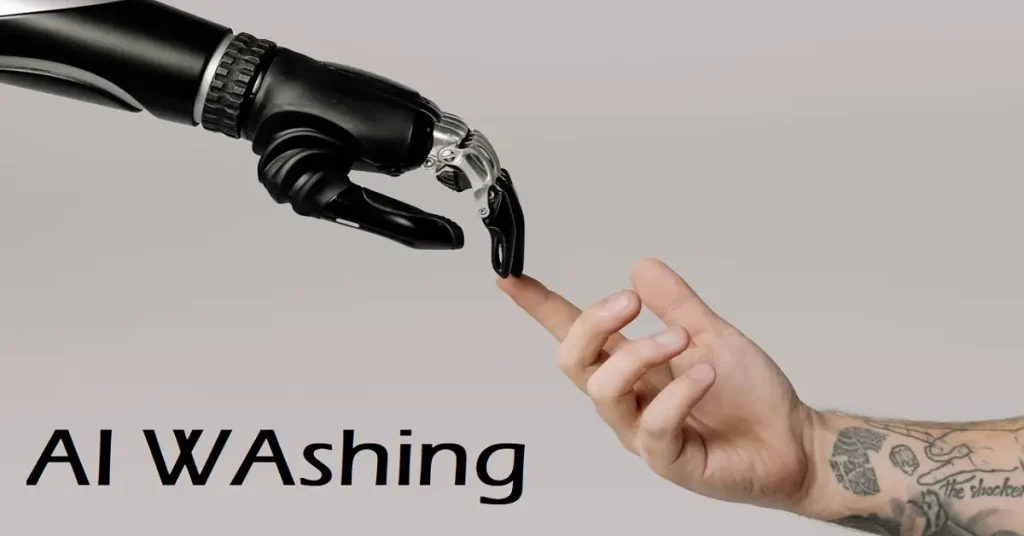AI washing is duping investors in 2025. Learn how 40 % of “AI” startups exaggerate, red flags to spot, and the free checklist that stops the hype
Scroll through LinkedIn today and every second tagline brags about “AI-powered everything.” Yet behind the buzzword, plenty of products still run on Excel macros, offshore reviewers, or a chatbot that is little more than a dressed-up FAQ. This gap between hype and reality has a name—AI washing—and it is quietly draining wallets, warping markets, and stalling real innovation.
The Amazon Fresh Reality Check
Remember the 2024 headlines that Amazon’s “Just Walk Out” grocery tech was 100 % autonomous? A leaked internal memo revealed that nearly 70 % of transactions still required a team of human reviewers in India to label video frames so the algorithm could learn. Amazon insists this is routine training oversight, but the takeaway is simple: if the world’s most data-rich retailer still leans on human eyes, smaller vendors probably do too.
What Actually Counts as AI Washing?
AI washing happens when marketing claims outrun the real role of artificial intelligence in a product. Common flavors include:
- Relabeling classic RELATED KEYWORD 1 rule-based software as “smart AI.”
- Adding a thin chatbot wrapper on top of legacy code and calling it “generative.”
- Promising future AI features that do not yet exist—classic vaporware with a new coat of paint.
The confusion thrives because “AI” itself is fuzzy. Technically, a toaster that uses a vision model to detect bread darkness is AI, but so is a hedge-fund engine that forecasts macro trends. The label alone tells buyers nothing about depth, reliability, or cost.
By the Numbers: 2025 Edition
A February 2025 survey by MMC Ventures of 1,200 fintech start-ups found:
- 40 % of companies that branded themselves “AI-first” had zero machine-learning code in production.
- 25 % simply piped third-party APIs such as OpenAI and added a new UI.
- Only 12 % trained proprietary models on unique data sets.
Meanwhile, funding rounds mentioning “generative AI” fetched 2.3× higher median valuations—clear evidence that exaggeration pays.
Why the Stretch Happens
Three forces collide:
- Capital magnet. Pitch decks with AI buzzwords close faster and larger.
- Competitive FOMO. Rivals fear sounding outdated if they speak plain English.
- Definition loophole. Regulators still lack a single legal yardstick for what counts as AI.
Imagine a founder demoing a loan-underwriting tool. Saying “we use gradient-boosted trees” draws blank stares; saying “AI-powered risk engine” lands the Series A term sheet.
Red Flags for Buyers & Investors
Spotting AI washing is easier than most think. Ask these four questions:
- Show the training data. Vague answers like “proprietary data lake” often mean “a CSV downloaded last year.”
- Request a sandbox. Real AI firms gladly let users upload their own dataset and watch live predictions.
- Check the team. Look for ML engineers with published papers or open-source commits, not rebranded web developers.
- Read the fine print. If the SLA promises 99 % accuracy but the contract disclaims all liability, raise an eyebrow.
Practical tip: Start with a free PRIMARY KEYWORD audit template—GitHub/ml-audit offers a checklist that scores vendors on transparency.
Regulators Strike Back
In March 2024 the SEC fined two investment advisors $400 k for claiming to use AI stock-picking when they were merely forwarding client orders to a robo-advisor. The FTC followed with “Operation AI Comply,” naming five firms that sold “AI lawyer” services powered by nothing more than template libraries. Similar fines are expected across Europe and APAC in late 2025 as the EU AI Act and Singapore’s Model AI Governance Framework roll out.
Hidden Costs When the Mask Slips
Beyond fines, AI washing can:
- Erode customer trust—think of the backlash when chatbots hallucinate medical advice.
- Trigger technical debt when promised “self-learning” systems need manual patches.
- Create systemic risk if thousands of fintechs secretly rely on the same third-party model.
Analysts now warn of a looming “monoculture” where a single API outage could freeze credit scoring across dozens of banks.
Future Outlook: From Hype to Hygiene
History rhymes. After the dot-com crash, “e-” prefixes became uncool; after the crypto winter, “blockchain” lost its sparkle. AI is heading the same way. Forward-looking buyers are shifting budgets to vendors with explainable AI, open benchmarks, and third-party model cards. The buzzword will fade, but real machine-learning value will remain.
Need the cheat-sheet?
Download the AI-washing checklist →
Caught a case of AI washing in the wild? Drop screenshots or stories in the comments and let’s crowdsource the hall of shame.
See More:
- Fartcoin Teeters on $0.90 Cliff: Will the Meme-Coin Miracle Hold or Fold?
- Dead NFT Comes Back: How Moonbirds Exploded From 0.29 ETH to 3 ETH in 90 Days
- The 150-Year Market Map That Keeps Calling Every Crash: What It Says About 2025 & 2026
- GPT-5 Just Beat Pokémon Red in 6,470 Moves—Here’s Why Gamers & AI Geeks Can’t Stop Watching

